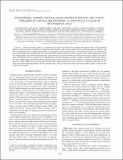| dc.contributor.author | JOHN MICHAEL ONG’ECHA, Christopher C Keller, Tom Were, Collins Ouma, Richard O Otieno, Zachary Landis-Lewis, Daniel Ochiel, Jamie L Slingluff, Stephen Mogere, George A Ogonji, Alloys S Orago, John M Vulule, Sandra S Kaplan, Richard D Day, Douglas J Perkins | |
| dc.date.accessioned | 2020-11-19T06:56:42Z | |
| dc.date.available | 2020-11-19T06:56:42Z | |
| dc.date.issued | 2006 | |
| dc.identifier.uri | https://repository.maseno.ac.ke/handle/123456789/2853 | |
| dc.description.abstract | Malarial anemia (MA) is a multifactorial disease for which the complex etiological basis is only partially
defined. The association of clinical, nutritional, demographic, and socioeconomic factors with parasitemia, anemia, and
MA was determined for children presenting at a hospital in a holoendemic area of Plasmodium falciparum transmission
in western Kenya. Parasitemia was not associated with malaria disease severity. In univariate logistic regression, fever
was significantly associated with parasitemia, and wasting was associated with increased presentation of MA. Caretaker’s
level of education and occupation were significantly correlated with parasitemia, anemia, and MA. Housing structure
was also significantly associated with parasitemia and anemia. Bed net use was protective against parasitemia but not
anemia or MA. Multivariate logistic regression models demonstrated that fever, mother’s occupation, and bed net use
were associated with parasitemia. In the current study, none of the factors were associated with anemia or MA in the
multivariate models. | en_US |
| dc.publisher | The American Society of Tropical Medicine and Hygiene | en_US |
| dc.title | Parasitemia, anemia, and malarial anemia in infants and young children in a rural holoendemic Plasmodium falciparum transmission area | en_US |
| dc.type | Article | en_US |

